2007 VOLKSWAGEN GOLF page 92
[x] Cancel search: page 92Page 3 of 444
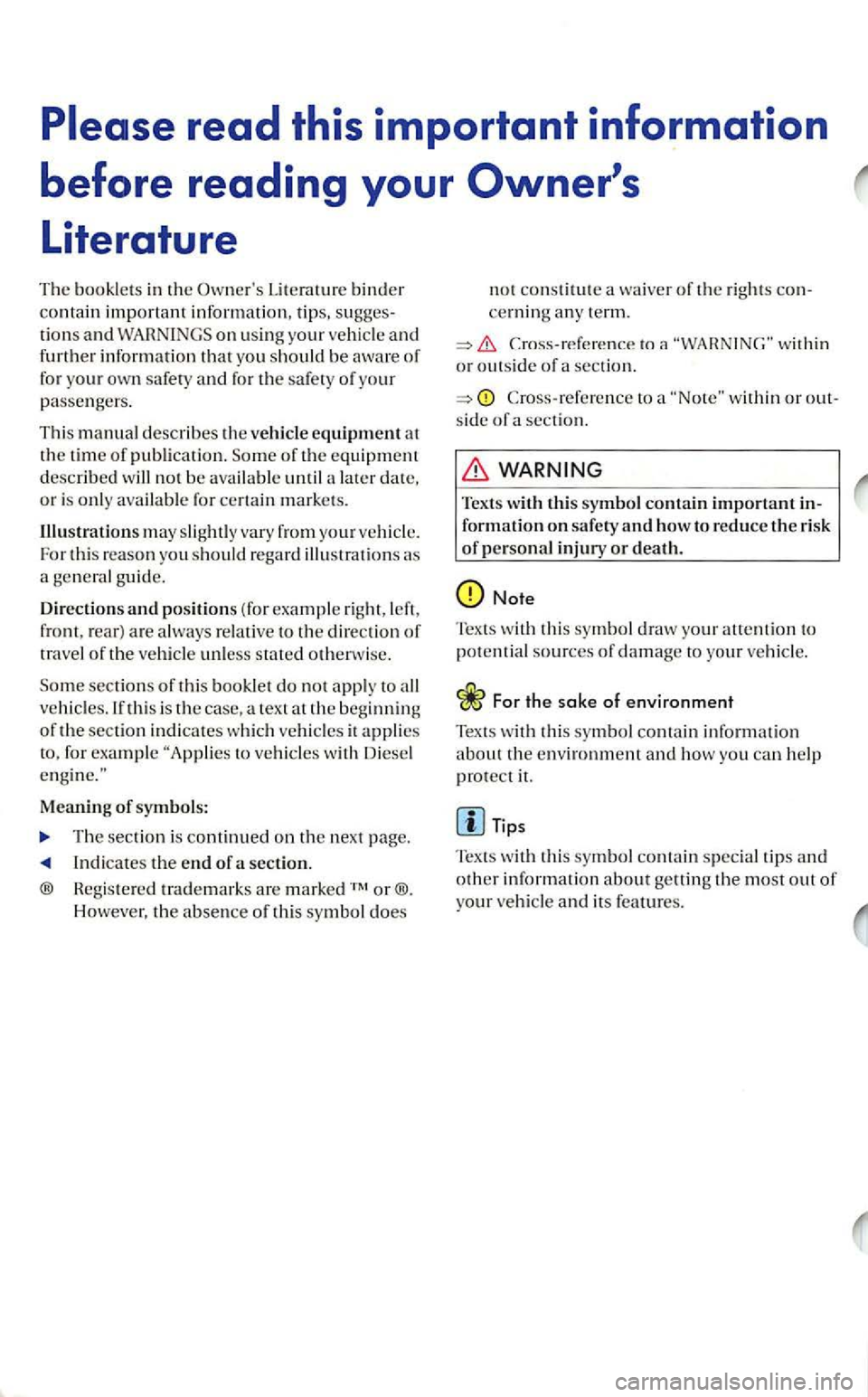
tions and on usin g your and further information that you sh o uld be aware of for your own safe ty and for the s afety of y our passengers .
This manual describes the vehicle equipment at the time of publication. Some of the equipment described will not be avai lable until later date. or is only available for certain markets.
Illu s
trations may slightl y vary from your For this reaso n you should regard illustrations as
a gen eral guide.
Directions
and positions (fo r exa mpl e right, left ,
front , rear) are alwa ys relative to the direction of travel of th e unless stated ot herw is e .
So me
section s of this booklet do not apply to vehicle s.Jfth is is the cas e, a tex t at the beginning oft he section indicates which it applies
to, for example to
The section is continued on the next page.
Indica tes the end of a section.
® Registered trademarks are m arked
withi n or outside of a sect ion.
Cross-ref eren ce to a ' "No te " with in or o u t
s id e o f a se ct ion .
Texts with this symbol contain important information on safety and how to reduce th e risk of p e rsonal injury or death.
Note
Tex ts w it h thi s symbol draw your atte ntion to potentia l sou rces of damage to your vehicl e.
Tips
Text s w ith thi s sy
mbol contain s pecia l tip s and other informat ion about getting th e most out of your vehicle a nd its featu res.
Page 6 of 444
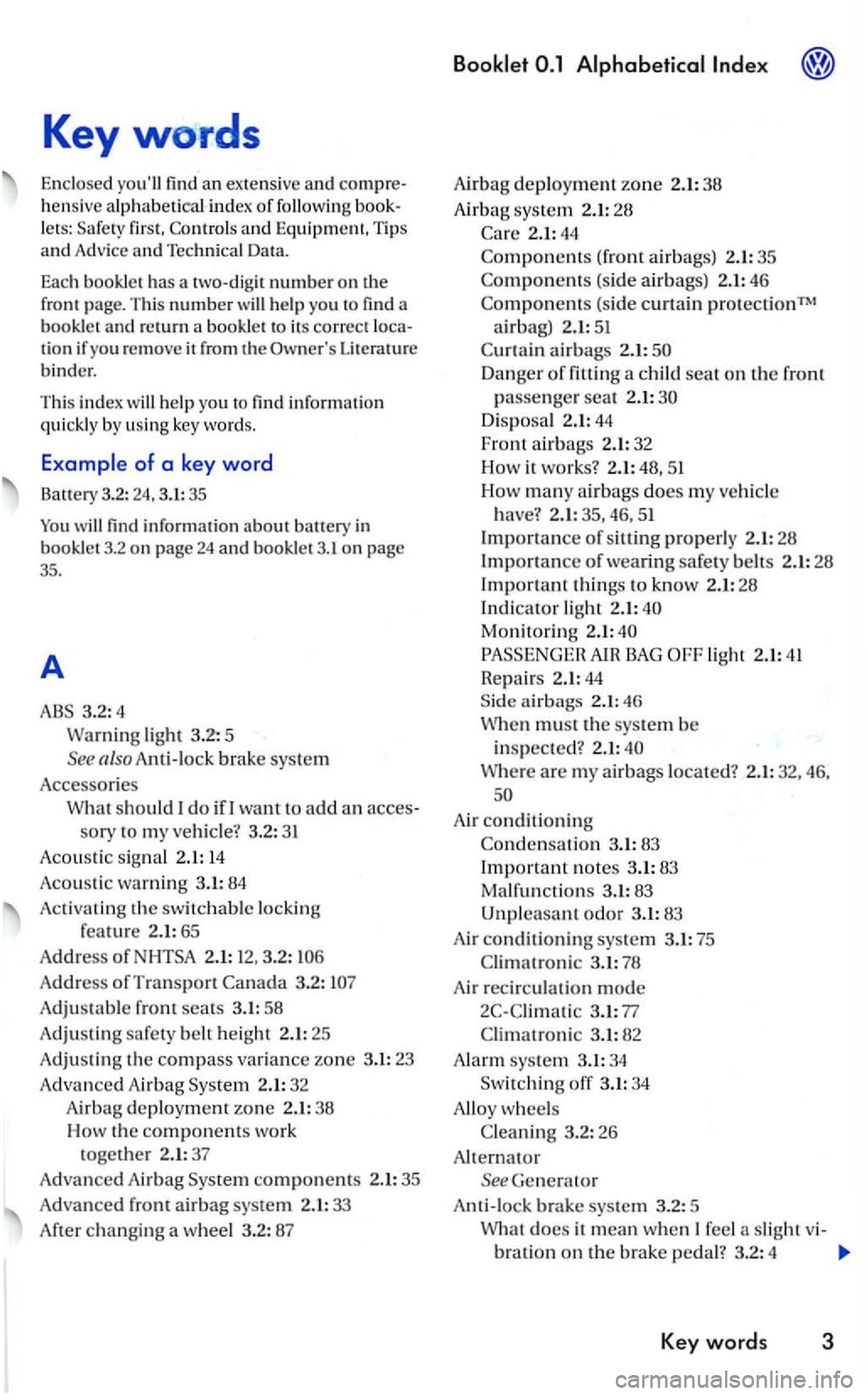
Keywords
Enclosed you'll find an extens ive and hens ive alp habet ical index of followi ng let s: first. and Equipm ent , T ips and Advice an d Techni cal Data.
Eac h bookle t has a
Literature
bind er.
This index will help you
of a key word
Battery 3.2: 24,3.1:35
You will find information about bauery in book le t3.2 o n pa ge 24 and booklet3. 1 on page 35.
A
3.2:4
ligh t 3.2 : 5
See also Anti-lock brake system
Accesso
ries
2.1: 12, 3.2:
Address of Transport
2.1: 32
Airbag d
eployment zone 2.1: 38 How th e co mponents work
together 2.1: 37
A dva nced Airbag
Airbag deployment zone 2.1: 38
A irba g sys te m 2.1: 28
2.1:44
(front airbags ) 2.1: 35
airbags 2.1:
Monitoring
AIR BAG light 2.1:4 1
Repair s 2.1:44
airbags 2.1: 46
Air conditi oning
3.1:83
Important notes 3.1:83
Ma lfuncti on s 3.1:83
Unpl
easant odor 3.1:83
Air conditioning sys te m 3.1: 75
3.1: 77
bration on the brake pedal? 3.2: 4
Key words 3
Page 26 of 444
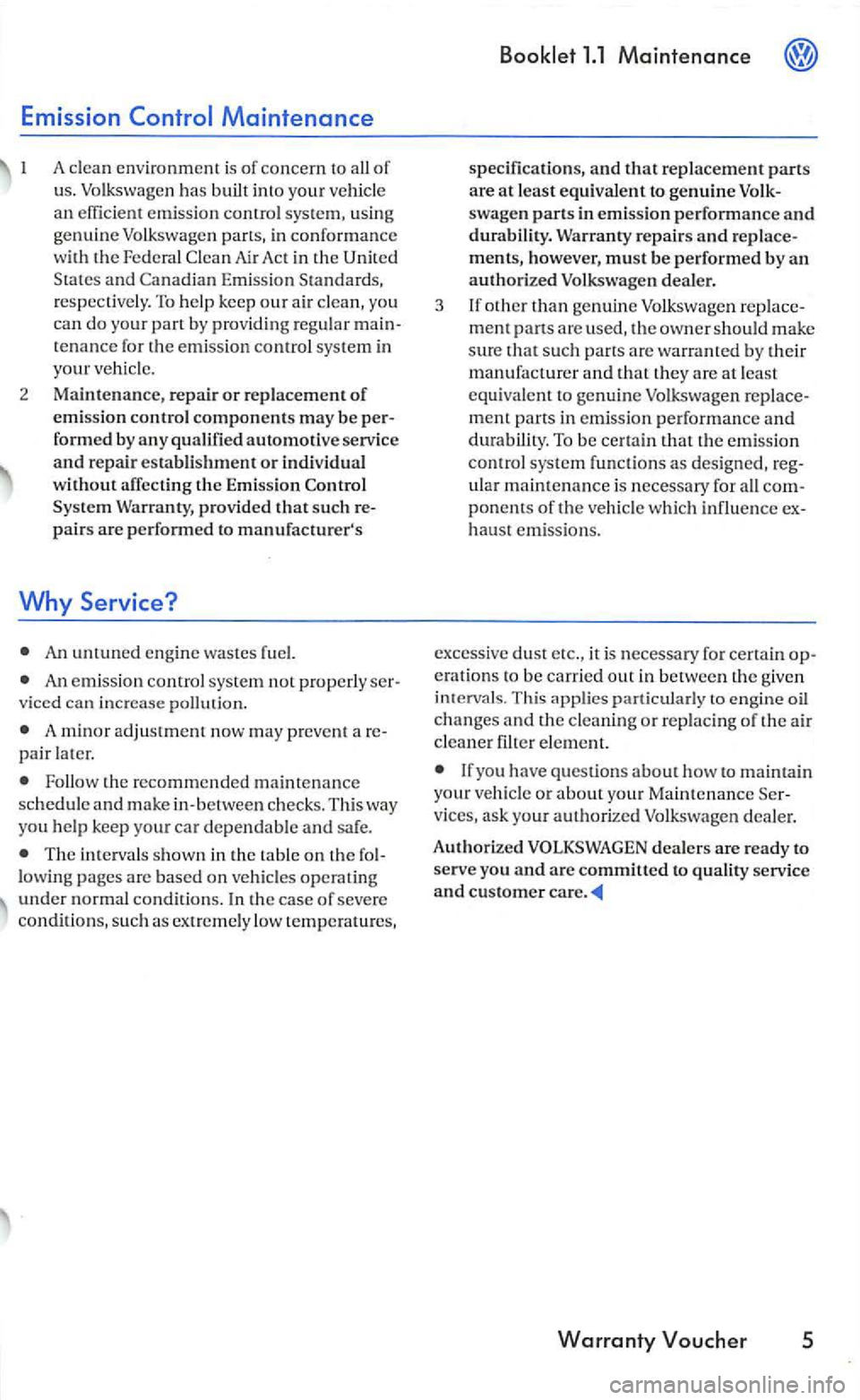
Emission
emission contro l sys tem, using genuine Volkswage n parts, in conformance with th e Fe d eral Clea n Air Act in the States and Canadian Emission Standards, respectively. To help keep our a ir clean, you
can do your part by providing regular tenance for th e emission control system in your vehicle.
2 Maintenance, r
epair or replacement of emission control compon ents may be formed by a ny qualified automotive service and repair establishment or individu al without affecti ng the Emission Control
Sys tem Warranty, provided that su ch pairs are p erformed to manufacture r' s
Why Service?
An untuned en gine wastes fuel.
An emission co ntrol system not properly
A minor adjustment now may p reve nt pair later.
Follow the recommended maintenance schedul e and make in-between ch ecks. This way
you he lp keep your ca r dependable a nd sa fe.
The interval s shown in the table on t h e lowing pages are based on ve hicles operating under normal conditions. I n the case of severe conditions, such as extremely low temperatures,
specifications, and that replacement parts
a re at least equiv alent to genuine s wagen parts in e mission perform ance and durability. Warranty repairs and
d eale r.
3 If ot
her than ge nuin e Volkswage n
parts in emission performance and durability . To be ce rtain th at the emi ssion cont rol sys tem function s as designed, ular mainten a nce is necessary for all ponents of the vehicle which influence haust emiss ions.
excessive
dust etc., it is necessary for certa in
If you have questions about how to mainta in
your vehicle or abou t yo ur Maintenance
dealers are ready to serve you and are committed to quality service
and customer care .
Warranty Voucher 5
Page 51 of 444
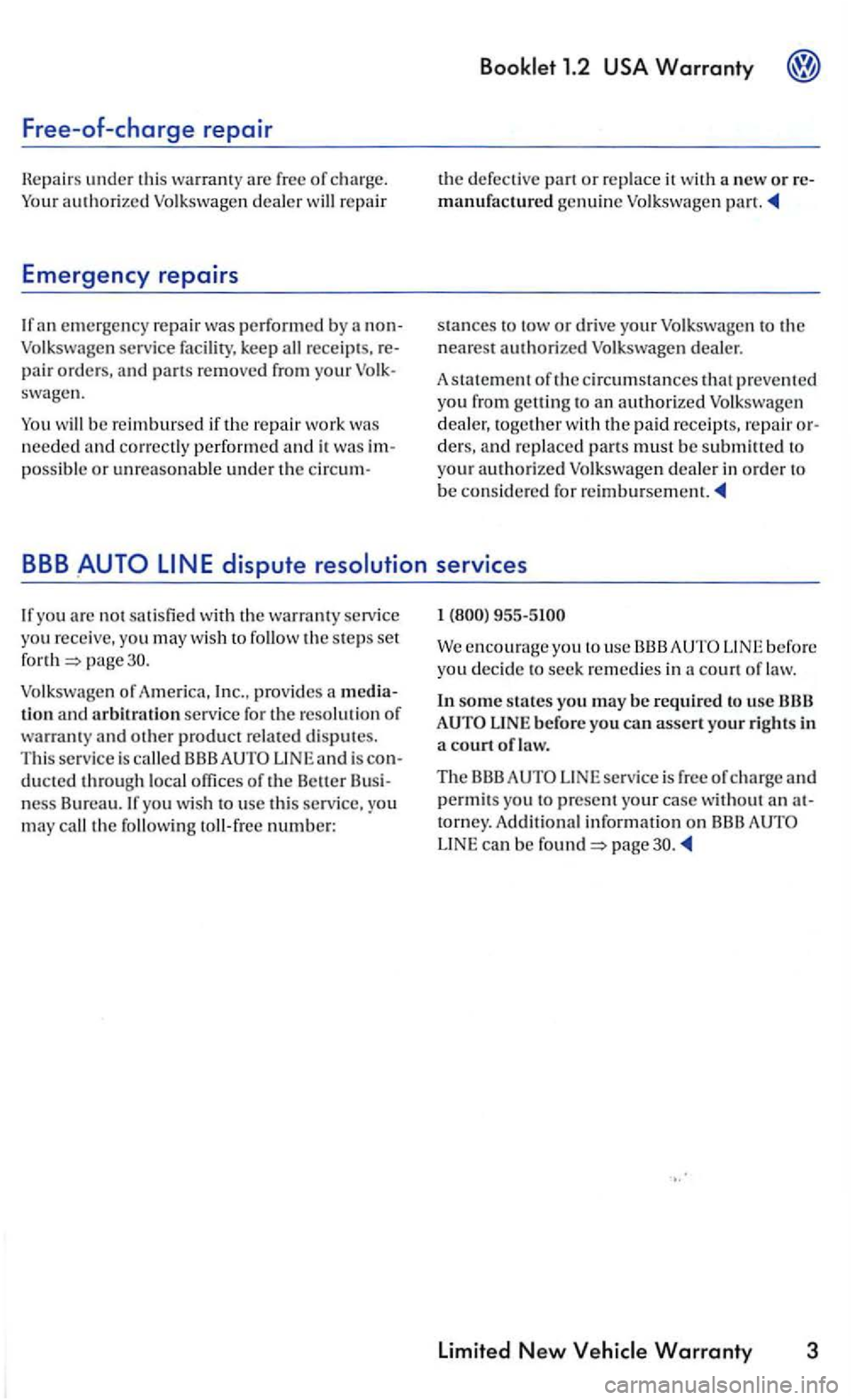
Free-of-charge repair
Hepair s under thi s warranty are free of charge.
a n emergency repai r was perfo rm ed by nonVolkswagen service facility, keep all receip ts. repair orders, and parts remove d from your swage n.
will be reimbursed if the repair work needed performed and it was impossible or unreasonable unde r the ci rcum-
1.2 USA Warranty
the defective pan or replace it with a new or remanufactured genuine Volkswag en part.
stances to tow or driv e your Volkswagen to the nearest authorized Volkswage n dealer.
A s tate
ment of the circumstances that prevented you from gelling to an authorized Volkswage n
dealer, together with the paid receipt s, repair orders, and re p laced parts must be submiued to
your authorized Volk swage n deale r in order to be consid ered for re imbursement.
page you decid e to seck remedies in court of law .
In some states you may be required to use AUTO LINE befor e yo u ca n assert your rights in a court of law.
The BBB AUTO LINE serv ice is free of ch arge and
p ermits you to prese nt your case withou t an at
t orney. Additional information on BBIJ AUTO can be page
Limited New
Page 88 of 444

About this
This booklet contains important information,
t ip s. s u gges tions
ature
Literatu re in the ve hicle . This is ci all y important w hen yo u len d or sell hi cle.
D ir
ections and positions (for exampl e front. rear) arc a lwa ys re lat ive the direction o f
travel of vehicl e unless sta te d otherw ise.
models only."
find any Supplements in Literature imme di ate ly the booklet.
A n a lphabetical index is at
of th e equipment describ ed not b e availabl e until a later or is only ava ilab le for certain mark ets.
a gen e ra l guid e.
The section is continued on th e next page.
end o f section.
® R
egistered trademarks a re absence of t h is symbol docs consti tu te a waive r of the rights cerning any term.
Cross- refere nce o r o ut side of a section.
Cross- refere nce a within or
section.
Text with this symbol contains importan t formation on safety and how to reduce the risk
o f p ersonal i njury or death.
your vehicl e.
For the sake of environment
Text w it h thi s symbol contains information a bout the environment and how you can help
protect it.
Tips
Tex t wit h thi s symbol co n tain s sp ecia l tips and other info rm atio n about gettin g the most o ut of
your vehicl e and its features.
Page 91 of 444
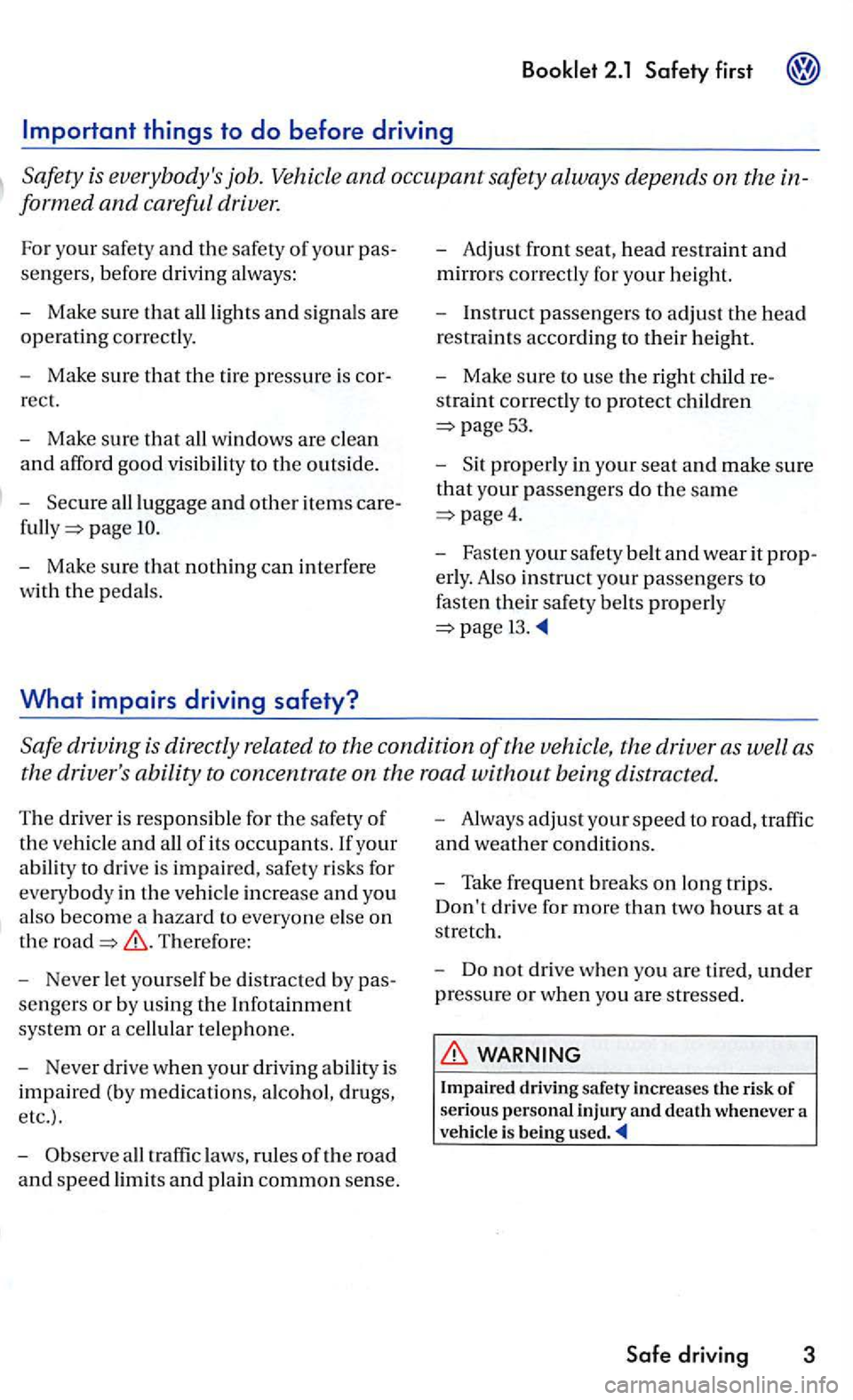
driver.
For your safety and the safety of your pas
sengers, before driving always:
- Make sure
that all lights and signals are
operating corr ect ly.
- Make su re
that the tire pres sure is cor
r
ect.
- Make sure that all windows are clean
and afford good visibility to the outside .
- Secure all luggage and
other items care
page
re
stra int correctly to protect children
53.
- S it properly in your seat and make sure
that your passengers do the same
4.
- Fasten your safety belt and wear it prop
erly. Also instruct your passenge rs to
fasten their safety belts properly
Safe driving is directly related to the condition of the vehicle, the driver as well as
the driver' s ability to concentra te on the road without being distracted.
The driver is responsible for the safety of
the vehi cle and all of its occupants. If your
ability to drive is impa ir ed, safety risks for
everybody in
the vehicle in crease and you
a lso becom e a hazard to everyo ne else
on
the There fo re:
- Never let yourse lf be di stracted by pas
sengers
or by using the Infotainm ent
syste m or a cellular tel ephone.
- Never drive w
hen your driving ability is
impa ired (by medication s, alco hol,
drugs,
etc.) .
- Observe a
ll traffic laws, rules of th e road
and speed limit s and plain common sense. -
Alway s
adjust you r speed to road, traffic
a
nd weathe r conditions.
- Take frequen t breaks on long trip
s.
Don't drive for more than two hours at a
s tretch.
-
Do n ot drive when you are tir ed, unde r
pressure
or when you are stresse d.
WARNING
Impaired driving safety increases the risk of serious personal injury and death whenever a
vehicle is being used
Page 93 of 444

inches (25 em) between your breastbone and the steering wheel.
Always hold the s teering wheel on the
Never hold the steering wheel at the 12 o'clock position or with your hands at other positions inside the steering wheel rim or on the steering wheel hub. Holding the steering
wheel the wrong way can cause serious
2.1 Safety first
(continued)
Always sit in an upright posit i on and never lean against or place any part of your body too
close to the area where the airbags are located.
strained.
Never adjust the seats the vehicl e is mov ing. Your seat may move unexpecte dly and yo u could lose control of the vehicle.
Never drive wit11 the backrest reclined or tilted far back! The fart her t11e backrests are tilted back, the greater the risk of injury due to
incorrect positionin g ofthe safety belt and
Children must always ride in child seats
page restraints on t11e front seat some important things to
Move the front passenger seat back as
far as possible. There must be a minimum
of
Adjust th e angle of the seat back so that
it is in an upright position and your back
comes in full contact with it whenever the
veh icle is moving.
Adjust the head restra int so that the
upper edge is as eve n with the top of your
h
ead as poss ible but not lower than eye
leve l
and so that it is as close to the back of
your head as
Keep both feet flat on the floor in the
footwell in fron t
of the front passenger
seat.
Fasten and wea r safety belt s co rrectly
13.
For detail ed inform ation on how to adju st the
front passenger bookl et 3.1 and s torage.""
WARNING
Front seat passengers who are unbelted, out of posit ion or too close to the airbag can be
risk of serious
Passengers must always sit in an upright position and nev er lean against or place any part of their body too clos e to the area where the airbags are located.
Passengers who are u nbelted, out
Safe driving 5
Page 94 of 444

Always make sure that there are at least
Each passenger must always sit on a seat of their own and properly fasten and wear the safety belt be longing to that seat.
Before driving , always adjust the front senger seat and head re straint properly.
Alway s keep your feet on the floor in front of the seat. Never rest them on the seat, ment panel, out of the window, etc. The airbag
tect you properly and can even increa se th e
risk of injury in a crash.
Neve r drive with the backre st recl ined or tilted far back! The farth er the b ackrests are
tilted back, the greater the risk ofinjury due to
in correct positioning of the safety belt and
must always ride in seats 53. a child seat on the front passenger page
Mak e sure that the seatback s are
curel y lat ch ed in the upright position.
A djust th e head restraint so that the
upper edge is as even with the top of your
head as possible but no lower than eye
pag e 7. If a passe nger is s ittin g in
the rear center seating pos ition, this
pac t h ead restra int is not h eight
a ble , but it must always bee n rais ed
eve r the center rear seating posit ion is
belt on
page 23
Keep both feet flat in the footwell in
front
of the rear seat.
6 Safe driving
Fasten and wear safe ty belt s properly
13.
Make sure that children are always
prop e
rly restra in ed in a child re str aint that
is appropriate for thei r size and age
5 3 .
WARNING
Pas sengers who are improperly seated on the rear seat can be se riou sly injure d in a crash.
Each passen ge r must always sit on a seat of th eir own and properly fasten and wear the safety belt belonging to that seat.
belt s only offer maximum tion when the seat back is securely latched in
th e upright po siti on and the safety belts are
properly positioned on the body. By not sitting
upright , a re ar seat pass enger increases the risk of personal injury from improperl y
Always adjust the head restraint properly so that it can give maximum